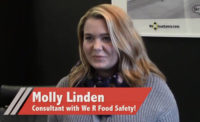Editor-in-chief Andy Hanacek spoke with We R Food Safety! consultant Molly Linden about heat resistant bacteria and what the biggest pitfalls are for producers.
Andy Hanacek: Molly, thanks so much for joining me for a couple minutes here. We wanted to talk a little bit about heat resistant bacteria and the threat of heat resistant bacteria to the meat and poultry industry. Can you give us an assessment on what that threat is, and how heat resistance happens in the bacterial world?
Molly Linden: To begin, heat resistant bacteria occur most often when the bacteria has been treated with heat at cooking temperatures which aren’t high enough inactivate the bacteria. This often happens in cooking times in the industry when you have a slow cook process, and at that time, temperatures aren’t high enough to completely inactivate the bacteria allowing it to survive the cooking process and grow later. This normally happens in the ranges between 40 degrees and 140 degrees, which are common times in the cook period where it needs to come up. If it sits too long, it oftentimes will create heat resistant bacteria. The point at which it’s a threat to the industry right now is that Appendix A has no point in it where it talks about the come-up time and how fast the cooking process has to go from 40 to 140 degrees. At this point, our producers are not informed about the heat resistant bacteria and their potential threat to the industry as well as it’s not in Appendix A, therefore the USDA has blatantly overlooked it. At this point, we are not entirely sure the research has not been done on it that tells us what can happen, how we can inactivate heat resistant bacteria once they become heat resistant, and how do we protect the consumers that might be susceptible to these heat resistant bacteria after they have entered a product.
Hanacek: What is the mechanism by which they form that heat resistance?
Linden: A lot of bacteria have different mechanisms in order to do it. For example, the most stable of all the heat resistant bacteria are those that form spores. These are bacteria when introduced to heat that does not inactivate them, they can become heat resistant by forming spores. Spores are a dormant state that the bacteria can enter in which their DNA is enveloped in very particular folded proteins which, once interacting with the heat, will not unfold therefore destroy the DNA. These will sit metabolically dormant years at a time, but as soon as the conditions are more viable for them, more able for them to grow, they will immediately come out of their spores forming their original form in which they can grow, reproduce, create toxins, and cause human illness. So these can sit inside spores for a long amount of time after they’re heat resistance. They will come out of their spores and they have the ability then to infect humans with human illness. Now there are other ones that do not form spores like Salmonella and E.coli. They are not as common in their heat resistant form, but at this point, they envelope themselves in different special proteins, enveloping their DNA, creating that heat resistance, which will then be able to cause human illness once they are ingested by humans.
Hanacek: So basically what you are saying is that the bacteria in a sense is that they grow a shell around the DNA that protects them. That’s how they develop this, right?
Linden: Exactly. Especially the spore-forming bacteria, they will be able to envelope their DNA, so it is protected and it can withstand those high temperatures. At this point though, those bacteria are more likely to withstand higher further on in their lifespan and also within the lifespan of the generations that they develop afterwards. So now you are getting into the point of how do you inactivate the heat resistant bacteria that are already in your product. What we know from studies now is that re-cooking it is not simply enough. Those bacteria have already learned to tolerate high temperatures and for long periods of time, and they simply cannot just be retreated with the same amount of heat in order to kill those bacteria. What we are seeing now are that producers would have to re-cook an entire batch of products that have those heat resistant bacteria in them but cook them to much high temperatures and for much more prolonged periods of time to the point where the product that they are creating after re-cooking it isn’t one that meets quality standards. So now you are getting to the point where producers are not only not informed about heat resistant bacteria or what causes it but they also aren’t being able to reprocess each of their batches in order to reduce that bacteria or inactivate those heat resistant bacteria. This leads to many producers just having to throw away product, which is a waste of money and a waste of time, and at that point, how do they ensure that future products won’t also be contaminated with heat resistant bacteria at that point in their process.
Hanacek: Right, and if their process is creating this situation, who knows what other products are going to have those kind of heat resistant bacteria develop. It makes sense.
Linden: Exactly. That’s why it is so important in Appendix A to have these procedures outlined for them: how they have to come-up on their cook times and how long they can withstand those before you start to create heat resistant bacteria.


